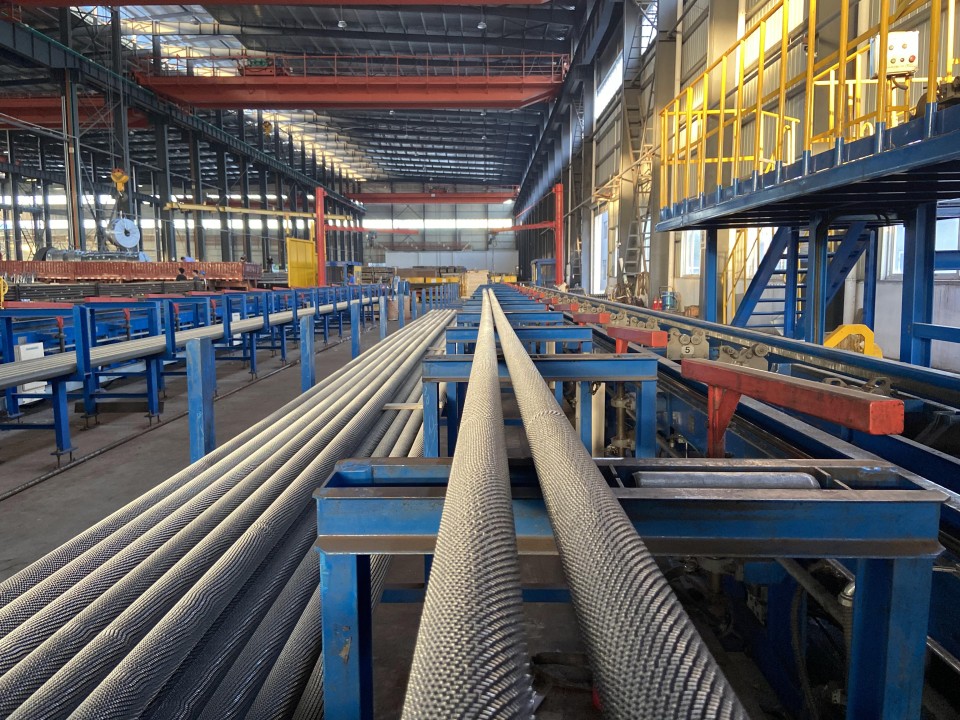The finned tubes in the boiler
Finned tubes in boilers are essential components designed to enhance heat transfer efficiency by increasing the surface area for heat exchange between the gas and liquid phases. These tubes are commonly used in economizers, superheaters, and air preheaters to maximize the recovery of residual heat from flue gases, thereby improving the overall efficiency and performance of the boiler. High-quality finned tubes, produced using advanced techniques like high-frequency welding, offer excellent durability, corrosion resistance, and thermal efficiency. Regular maintenance and inspection are crucial to ensure their optimal performance, longevity, and energy savings, contributing to lower fuel consumption and reduced emissions in industrial and power plant applications.
Application of Finned Tubes in Boilers
1. Heat Transfer Enhancement:
Finned tubes are designed to maximize the surface area for heat transfer, which helps in improving the efficiency of the boiler.
The fins increase the external surface area without significantly adding to the overall volume, making the heat transfer process more effective.
2. Energy Efficiency:
By improving the heat transfer rate, finned tubes help in reducing fuel consumption, thereby enhancing the overall energy efficiency of the boiler system.
3. Compact Design:
The use of finned tubes allows for a more compact boiler design as they achieve higher heat transfer rates in smaller volumes.
4. Temperature Regulation:
They help in maintaining uniform temperature distribution within the boiler, which is crucial for the efficient operation and longevity of the boiler.
5. Durability and Longevity:
High-quality finned tubes, such as those produced using high-frequency welding techniques, offer excellent durability and resistance to thermal stresses and corrosion, ensuring a longer lifespan for the boiler.
Applications of Finned Tubes in Boilers
1. Economizers:
Function: Finned tubes are used in economizers to preheat the feedwater entering the boiler using residual heat from flue gases. This preheating process increases the overall efficiency of the boiler.
Benefit: By recovering waste heat, economizers reduce fuel consumption and lower operational costs.
2. Superheaters:
Function: In superheaters, finned tubes are used to further heat the steam produced in the boiler. This increases the temperature and pressure of the steam, enhancing its efficiency for power generation or industrial processes.
Benefit: Higher steam temperatures improve the efficiency of steam turbines and other steam-driven equipment.
3. Air Preheaters:
Function: Finned tubes in air preheaters are used to heat the air entering the combustion chamber. This is done by utilizing the residual heat from the flue gases.
Benefit: Preheated air improves combustion efficiency, reduces fuel consumption, and lowers emissions.
4. Heat Recovery Steam Generators (HRSG):
Function: In HRSG systems, finned tubes recover heat from exhaust gases of gas turbines to produce steam for power generation.
Benefit: This application significantly improves the overall efficiency of combined cycle power plants by utilizing waste heat.
5. Flue Gas Coolers:
Function: Finned tubes are used in flue gas coolers to extract heat from flue gases before they are released into the atmosphere.
Benefit: This helps in energy recovery and reduces the temperature of gases, thereby lowering the thermal impact on the environment.
Specific Uses in Industrial and Power Plant Boilers
1. Industrial Boilers:
Function: Finned tubes are used in industrial boilers to enhance the heating process for various applications such as chemical processing, food and beverage production, and manufacturing processes.
Benefit: Improved heat transfer leads to better temperature control and energy efficiency in industrial processes.
2. Power Plant Boilers:
Function: In power plants, finned tubes are crucial in components such as economizers, superheaters, and reheaters to maximize heat recovery and steam production efficiency.
Benefit: Enhanced efficiency of boilers in power plants contributes to increased electricity generation capacity and reduced fuel costs.
Types of Finned Tubes Used in Boilers
These are commonly used in boilers due to their efficient heat transfer capabilities. The fins are helically wrapped around the tube, providing a large surface area.
These have fins running longitudinally along the length of the tube. They are particularly useful in applications where space constraints are significant.
3. High-Frequency Welded Finned Tubes:
These tubes are manufactured using high-frequency welding, which ensures a strong bond between the fins and the tube, enhancing their thermal efficiency and mechanical strength.
Benefits of Using Finned Tubes in Boilers
1. Improved Heat Transfer Efficiency:
Finned tubes significantly increase the rate of heat transfer, making the boiler more efficient in converting fuel into usable heat.
2. Reduced Fuel Consumption:
Enhanced heat transfer leads to lower fuel consumption, which can result in significant cost savings over time.
3. Compact and Lightweight Design:
The increased efficiency of finned tubes allows for a more compact and lightweight boiler design, which is beneficial in space-constrained installations.
4. Reduced Emissions:
By improving the efficiency of the boiler, finned tubes help in reducing the overall emissions, contributing to a cleaner environment.
5. Cost-Effectiveness:
The long-term savings in fuel costs and maintenance make finned tubes a cost-effective choice for boiler systems.
Maintenance and Inspection of Finned Pipe in Boiler
Regular inspection and maintenance of finned tubes are essential to ensure their optimal performance. This includes checking for any signs of wear, corrosion, or damage to the fins and tubes.
Cleaning the finned surfaces to prevent fouling and buildup of deposits is crucial for maintaining high heat transfer efficiency.


